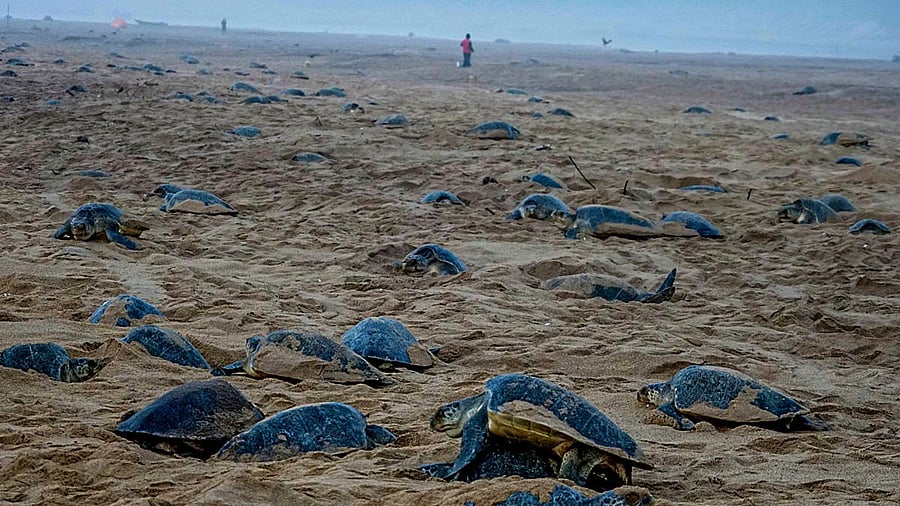
Olive Ridley turtles
Credit: PTI Photo
New Delhi: Olive Ridley turtles nesting on the Odisha coast are increasingly giving birth to more female off-springs, thanks to rising nest temperature due to climate change, ecologists in Bengaluru have found.
The hatchling sex ratio from mass nesting at Rushikulya was found to be about 71 per cent female on average, they reported after observing the rookeries for over 15 years. In some years, more than 80 per cent of the hatchlings were females.
Conservationists from the Indian Institute of Science, Bengaluru and Dakshin Foundation with support from the Odisha forest department have come out with a report that shows 97 per cent of the hatchlings were female in 2011, 83 per cent in 2012, 89 per cent in 2015 and 97 per cent in 2020. The scale was tilted towards the female, in most of the other years too,
“Climate change can affect the sex ratio of sea turtles, which we have shown in olive ridley turtles at Rushikulya. We expect a similar feminisation trend in other sea turtles like leatherback or green turtles, but we don’t have evidence yet” Kartik Shanker, a professor at IISc and the lead author of the report told DH.
Shanker said studies carried out in other parts of the world, including Australia and USA, showed how global temperature rise was making the sea turtle population more feminine. The observations at Rushikulya provide first such evidence from India.
One of the most impressive spectacles in nature is the ‘arribada’ or mass nesting of the Olive Ridley turtle, when tens or hundreds of thousands of female turtles come ashore to nest simultaneously. Gahirmatha and Rushikulya in Odisha are two of the largest rookeries worldwide, with other similar sized rookeries found only in Mexico and Costa Rica.
Last week, Rushikulya witnessed one of the largest mass nesting in recent years, with 400,000 to 500,000 turtles nesting in the span of just a few days. Sections of the beach were packed so thick with turtles that there was barely any place to walk.
The report also includes research on the monitoring of nesting trends, post-nesting, migratory patterns and genetic studies on leatherback turtles found in Andaman and Nicobar Islands; and foraging patterns of green turtles in Lakshadweep.
The largest of all sea turtle species weighing over 500 kg, the leatherback turtles grow over six feet in length. They feed solely on a diet of jellyfish.
The nest monitoring programme in the South and West Bay beaches of Little Andaman Island reveals a steady increase in leatherback nesting in the region. The beaches of Great and Little Nicobar Islands exhibit the highest nesting in the region, with over 1,000 nests per season.
The scientists tagged 10 leatherbacks between 2011-14 to observe their migratory patterns and found that the turtles swam across the Indian Ocean to reach the waters of western Australia and eastern Africa.
“We now have funds and official permission to tag ten more leatherbacks and will start the work from December, 2025,” Shanker said, noting that more studies would be required to check if the turtles follow any other migratory routes.
“Although recent trends suggest that the population (of leatherback turtles) is resilient, permanent alterations to beaches could have a significant impact on nesting in the Andaman and Nicobar Islands. Therefore, these nesting sites must continue to be protected from large-scale developmental projects,” the report adds.
